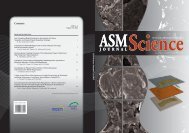Download - Akademi Sains Malaysia
Download - Akademi Sains Malaysia
Download - Akademi Sains Malaysia
Create successful ePaper yourself
Turn your PDF publications into a flip-book with our unique Google optimized e-Paper software.
Journal of Science and Technology in the Tropics (2010) 6: 59-65<br />
Prompt gamma neutron activation analysis (PGNAA) of hydrocarbons:<br />
A Monte Carlo study with GEANT4<br />
Lam YiHua1 , Wong Chiow San1 * and Kurunathan Ratnavelu2 1Plasma Research Laboratory, Department of Physics, Faculty of Science, University of Malaya,<br />
50603 Kuala Lumpur, <strong>Malaysia</strong><br />
2Institute of Mathematical Sciences, University of Malaya, 50603 Kuala Lumpur, <strong>Malaysia</strong><br />
*Corresponding author<br />
Abstract In the present work, the results of prompt gamma (γ) neutron activation analysis (PGNAA)<br />
calculated by the open source GEANT4 Monte Carlo toolkit were compared with the commercial simulation<br />
package MCNP. Both the Monte Carlo simulation packages utilize the phenomenological nuclear reactions<br />
to yield γ rays which are coupled with incident neutrons after these reactions. A virtual experimental setup<br />
with a 4π solid-angle γ detection was instantiated in the simulations to collect all prompt γ rays from the<br />
tested hydrocarbon phantoms. The comparative results present good agreement in getting the characteristic<br />
γ energy spectra of hydrocarbon materials.<br />
Keywords GEANT4 – MCNP – Monte Carlo simulations – prompt gamma neutron activation<br />
INTRODUCTION<br />
A material with its specific chemical composition and<br />
density can be detected or differentiated from among<br />
other types of materials, which have nearly the same<br />
chemical composition but have not complied with the<br />
same densities, by using prompt gamma (γ) neutron<br />
activation analysis (PGNAA) method. It has been<br />
used in detecting explosive hydrocarbon material [1].<br />
In addition, certain element in a bulk material or in a<br />
biological tissue can be determined via PGNAA, e.g.<br />
biomedical protein detection [2].<br />
PGNAA method relies on neutron-nuclear<br />
interactions, that is, inelastic scattering (n, n′γ), (n, pγ)<br />
and radiative capture (n,γ), to yield γ rays. Although<br />
1/v law [3] (v is the incident neutron velocity) is not<br />
applicable to every element, isotope and energy range<br />
[4], it is still acceptable to be applied in low Z element<br />
and in thermal energy range [5]. This law infers that<br />
the probability of neutron radiative capture depends<br />
on how long the period of time a neutron spends in<br />
the region surrounding the nucleus. The longer period<br />
of time it spends, the higher probability of neutron<br />
radiative capture will occur. Hence, when a low<br />
kinetic energy incident neutron, e.g. thermal neutron<br />
(~0.025eV) or epithermal neutron (0.1-1eV), enters the<br />
narrow separation virtual energy levels in compound<br />
nucleus or interacts with compound nucleus [6], the<br />
neutron radiative capture cross sections will increase.<br />
These low energy interactions raise the possibility of<br />
producing stable isotopes and the coupled γ ray, e.g.<br />
1 H(n, γ) 2 H in which 2 H is a stable isotope and γ ray will<br />
be radiated. Besides, different materials composed by<br />
different chemical compositions (including different<br />
isotopes) and densities will have different radiative<br />
capture cross sections. By radiating low energy<br />
neutrons with certain range of energy distribution on<br />
different materials, the produced γ ray energy spectra<br />
will be different. Hence, the prompt γ ray energy<br />
spectra become an identifying characteristic of the<br />
material.<br />
Other than experimental measurements, PGNAA<br />
can be simulated by using various types of Monte<br />
Carlo computational simulation packages, such as<br />
GEANT4 [7,8], MCNP [9] and FLUKA [10,11].<br />
Most of these packages are written in structural<br />
programming language (C and FORTRAN). GEANT<br />
4 has been written in object-oriented programming<br />
(OOP) architecture (C++), developed and maintained<br />
by many laboratories [7,8]. Conceptually, OOP has<br />
its distinctive feature in treating particle as a single<br />
object which may have encapsulated its own data<br />
Jostt vol 6.indd 59 7/22/10 10:09:51 PM<br />
59

















